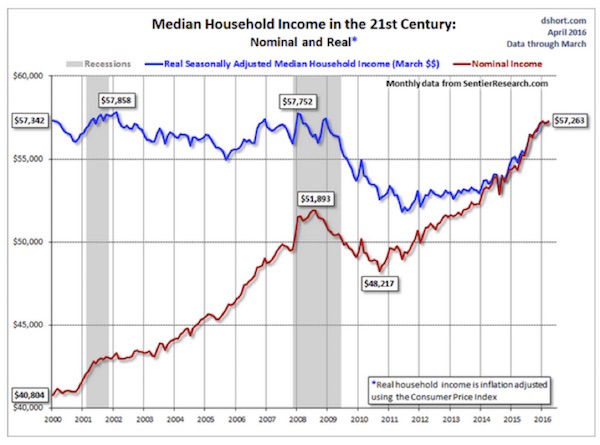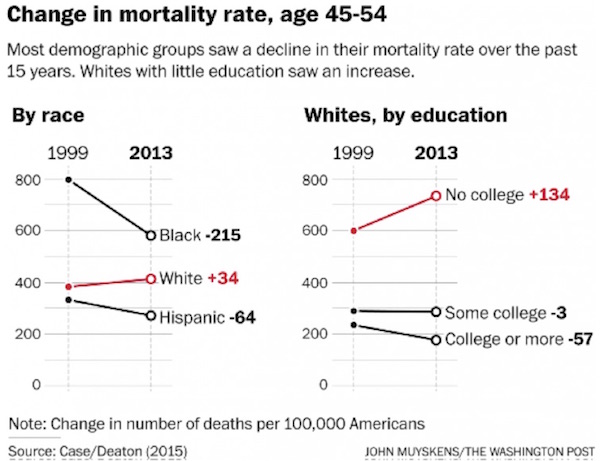Young workers feel a different kind of pain. Too young to have lost jobs in the recession, they reached adulthood in a labor market that doesn’t want them. That is especially true for those without college degrees.
The April jobs report showed a staggering 16.0% unemployment rate for teenagers ages16–19. This sample includes only those who were actively looking for jobs, so these aren’t full-time students. They have either dropped out, or they want to work while in school. They probably aren’t happy with the situation, and their parents aren’t, either.
Inflation Lives
While central bankers try to create inflation, for the unprotected inflation never disappeared. Last week in Outside the Box, I quoted Rob Arnott’s study that found inflation for most Americans has been running around 3% annually since 1995. That figure includes the four categories that typical workers are most keenly affected by: rent, food, energy, and medical care. (See “Where’s the Beef?”)
I ran across another shocking data point after sharing Rob’s story. It was in a May 8 Wall Street Journal story called “Rising US Rents Squeeze the Middle Class.” It looks at data that shows middle-income renters have it worse than those above or below them. Buried in the middle of the article was this sentence:
In Boston, median asking rents have increased at an annual rate of 13.2% since 2010, far outstripping the 2.4% average annual increase in income.
If Boston reflects other cities, we can see why people complain about rent and sleep on each other’s couches. This kind of steep climb in the cost of living is very hard on people who have little income to spare.
The following chart comes from Sentier Research (via Doug Short). The blue line is real median household income, which now stands at $57,263. That is, half of US households earn less than that. The picture is actually even worse since, as we saw above, the Consumer Price Index understates inflation for low-end households. Nominal wages may be growing – for those who have jobs – but in real terms the unprotected are falling farther behind every year.

When I look at that chart, I don’t wonder that half the country is furious at the protected class; I wonder what took them so long.
Everything I’ve said about the US applies to most of the developed world. The UK will vote next month on whether to exit the European Union, in part because of the perception that EU policies leave UK workers at a disadvantage. Unemployment rates in Southern Europe are astronomically high, even as refugees pour in from the Middle East. Collapsing commodity and energy prices are hitting Canada and Australia very hard.
Yet in all these places, a portion of society is still doing very well. Why is that? One common thread is central bank policy. The Fed, the ECB, and others decided years ago to push rates down and keep them there. Maybe they honestly thought that would help restore growth. It hasn’t, at least not growth that most people can appreciate.
Let’s be generous and say the central banks made an honest mistake. Bernanke, Yellen, Draghi, and colleagues all wanted to help people. At some point, you would think they might have to say, “It hasn’t worked.” Maybe they already say it among themselves but don’t tell us because they want to preserve what is left of their credibility.
I’m sorry, but at this point there isn’t much credibility left to preserve. The unprotected public has lost faith and is rising up, led by populists and demagogues.
The time for wondering where the anger came from is past. We know where it came from, and it’s too strong to stop now. We will all be living on the edge before this is over. Even the protected don’t have unlimited protection.
Conservative and Republican establishment types are trying to tell themselves that Trump is an anomaly. Things will go back to normal in time. But if there aren’t major changes – and I’m really wondering how those changes can happen, especially in a Clinton presidency – what do you think the mood of the voters will be in 2020, after the near statistical certainty of a recession within the next four years? Unemployment will once again be high and climbing; pensions will be threatened left and right; and there will be even more people living on the edge.
I highlighted a recent study that shows the surprisingly higher death rate among middle-aged whites. That rate is the direct result of increased suicides and abuse of drugs and alcohol – all part of the psychological depression process. And then, while researching today’s letter, I ran across a story in the Washington Post with the intriguing title “Death predicts whether people vote for Donald Trump.” It turns out that there is a direct relationship between the middle-aged mortality rates and the percentage of voters who favor Donald Trump in counties where mortality rates are the highest.
That fact becomes more alarming when you look at the context. Over the past decade, Hispanic people have been dying at a slower rate. Black people have been dying at a slower rate; white people in other countries have been dying at a slower rate.

“There’s something happening here; what it is ain’t exactly clear.”
I think we have crossed a political Rubicon. While money is important in the political process, the unprotected have discovered that their votes are even more important. And that there are more of them than there are of the protected. And that, if you’re in the unprotected class, your vote is not for sale.








